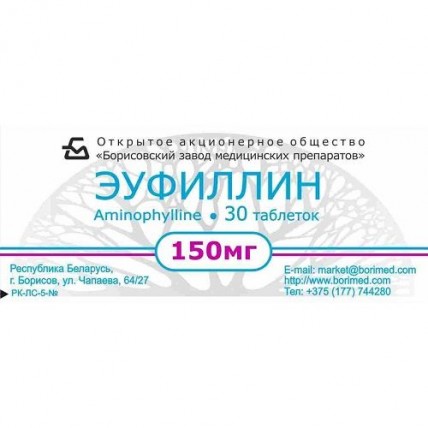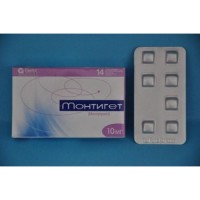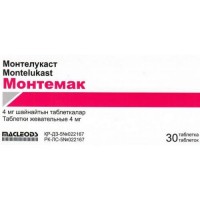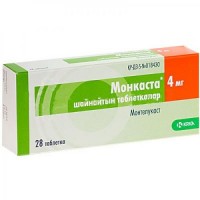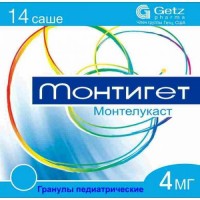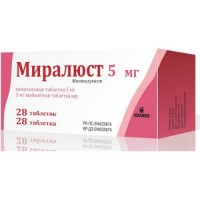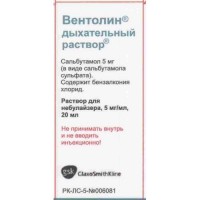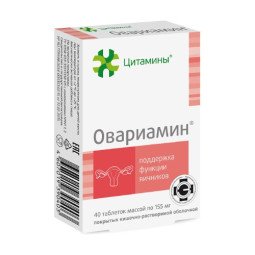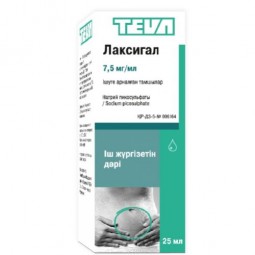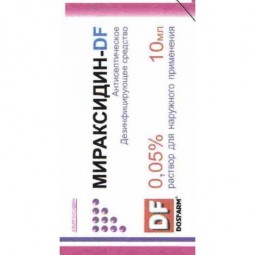Euphyllin (Aminophylline) 150 mg, 30 tablets
- $5.00
The instruction for medical use
of medicine
Euphyllinum
the Trade name
Euphyllinum
the International unlicensed
name Aminophyllinum Dosage Form
of the Tablet of 150 mg
Structure
One tablet contains
active agent – Aminophyllinum – 150 mg,
excipients: potato starch, povidone, magnesium stearate.
The description
of the Tablet of color, white or white with a yellowish shade, ploskotsilindrichesky, with a facet.
Pharmacotherapeutic group
Other drugs for treatment of obstructive respiratory diseases for system use. Xanthines
the ATX R03DA05 Code
the Pharmacological
Pharmacokinetics At properties intake is soaked up quickly and rather fully. The bioavailability of Euphyllinum is 80-100%. Alcohol increases the speed and completeness of absorption. Bronchodilatory action is shown at maintenance of its concentration in blood plasma at the level of 10-20 mkg/ml, the stimulating influence on a respiratory center is implemented at lower concentration – 5-10 mkg/ml. Concentration of Euphyllinum in plasma over 20 mkg/ml is toxic.
Well gets through gistogematichesky barriers and it is evenly distributed in blood, extracellular liquid and muscle tissue. In fatty tissue does not collect. Gets through a placental barrier and into mother's milk. The volume of distribution is 0.3-0.7 l/kg (on average 0.45 l/kg).
Is exposed to intensive metabolism in a liver (about 90%), under influence metilaz and P450 cytochrome partially passes into caffeine. At children up to 3 years owing to high metilazny activity of hepatocytes and slow elimination of caffeine its concentration can reach 30% of concentration of Euphyllinum. At adults and children is more senior than 3 years of a phenomenon of cumulation of caffeine it is not observed.
It is allocated with kidneys, and adults have 10% and children have about 50% – in not changed look. The period of semi-elimination of Euphyllinum (Т½) depends on age and associated diseases. At newborns and children up to 6 months it makes also gt, 24 h, at children 6 months – 3.7 h, at the adults who do not have bronchopulmonary pathology – 8.7 h are more senior. At the persons smoking 20-40 cigarettes a day Т½ it is shortened up to 4-5 h, and after refusal of smoking the restoration of speed of elimination of Euphyllinum happens only in 3-4 months. At persons with obstructive diseases of lungs, heart failure and a pulmonary heart the period of semi-elimination is extended up to 24 h. Alcohol intake and caffeine - the containing drinks slows down elimination of Euphyllinum and increases its level in an organism.
The pharmacodynamics
Euphyllinum renders the bronkhodilyatiruyushchy, vasodilating, spasmolytic, tokolitichesky and diuretic action.
The mechanism of action is connected with the blocking influence on A2 type of purine receptors of smooth muscle cells of bronchial tubes. Decrease of the activity of receptors breaks transport of calcium ions interfaced to them in a smooth muscle cell and causes its relaxation. In high concentrations Euphyllinum inhibits activity of phosphodiesterases III and IV of types that leads to the termination of hydrolysis of tsAMF, stabilization of its level in a cell and to maintenance of a kinase of light chains of myosin in an inactive fosforilirovanny state. Suppression of activity of a kinase of light chains of myosin does not allow it to interact with actin and to provide reduction of a cell.
Euphyllinum causes relaxation of smooth muscles of bronchial tubes, coronary, cerebral and pulmonary vessels, muscles of digestive tract and biliary tract. Owing to reduction of discharge of a histamine and leukotrienes from mast cells Euphyllinum reduces hyperreactivity of airways in response to intake of allergens in them.
Euphyllinum increases contractility skeletal (including respiratory muscles – diaphragms, intercostal muscles) and slows down development of their exhaustion. Has the stimulating impact on a cardiac muscle increasing force of its reduction (the positive inotropic action which is possibly connected with influence on activity of phosphodiesterase III of type).
Vasodilatation of renal balls is followed by increase in filtration of blood in kidneys and short-term increase of a diuresis.
Stimulates a respiratory center of a medulla, due to increase in its sensitivity to the stimulating influence of carbon dioxide, improves alveolar ventilation, and, finally, causes decrease in frequency and weight of episodes of a night apnoea.
Euphyllinum suppresses rhythmic reductions of a pregnant uterus, increases secretion of hydrochloric acid in a stomach, slightly improves rheological properties of blood (its viscosity) due to decline in the ability of thrombocytes to adhesion and aggregation.
Indications
- chronic obstructive bronchitis
- bronchial asthma (prevention of a bronchospasm, choice drug in asthma of physical tension, an additional tool at other forms of asthma)
- emphysema of lungs
- night paroxysmal an apnoea (Pikvik's syndrome)
- a chronic pulmonary heart
Apply the Route of administration and doses inside after a meal, washing down with a large amount of liquid. The dose of drug is selected individually, considering a possibility of various clearance rate of drug at different patients. Calculation of a dose is carried out proceeding from ideal body weight (since drug is not distributed in fatty tissue).
To adults and teenagers with body weight more than 50 kg depending on a clinical situation appoint 150-300 mg (1-2 tablets) 3 times a day, in hard cases on 300 mg (2 tablets) 4 times a day with an interval of 6 hours. A daily dose on average 600-1200 mg or 4-8 tablets in 3-4 introductions. Patients with body weight have less than 50 kg and teenagers with the body weight of 45-55 kg appoint 150 mg (1 tablet) 3-4 times a day. The daily dose should not exceed 600 mg.
To children of 6-17 years drug 3 times a day appoint in a dose 13 mg/kg of body weight, usually on 150 mg (1 tablet).
Side effects
- dizziness, a headache, insomnia, excitement, uneasiness, irritability, a tremor
- heartbeat, tachycardia, arrhythmias, a cardialgia, a lowering of arterial pressure, increase in frequency of attacks of stenocardia
- a gastralgia, nausea, vomiting, a gastroesophageal reflux, heartburn,
exacerbation of a peptic ulcer, diarrhea, a loss of appetite,
- skin rash, an itching
- fever
- a stethalgia
- a tachypnea
- feeling of inflows to the person
- an albuminuria, a hamaturia, a hypoglycemia,
- strengthening of a diuresis
- the increased sweating
Side effects decrease at a drug dose decline.
Contraindications
- hypersensitivity to drug components (including to other derivatives of xanthine: caffeine, pentoksifillin, theobromine),
- epilepsy
- a peptic ulcer of a stomach and a 12-perstny gut (in an aggravation stage)
- gastritis with hyperoxemia
- arterial hyper - or hypotension of a heavy course
- a tachyarrhythmia
- a hemorrhagic stroke
- an eye retinal apoplexy
- a hyperthyroidism
- intake of ephedrine (at children)
- children's age up to 6 years
Medicinal interactions
Ephedrine, β-adrenostimulyator, caffeine and furosemide strengthen effect of drug.
In a combination with phenobarbital, Phenytoinum, rifampicin, an isoniazid, carbamazepine and Sulfinpyrazonum the Euphyllinum metabolism acceleration is observed that is followed by decrease in its effect and can demand increase in the applied drug doses.
At the smoking persons (20-40 cigarettes a day) Euphyllinum metabolism acceleration is also observed that is followed by decrease in its effect and can demand increase in the applied drug doses.
When assigning in a combination with antibiotics of group of macroleads, lincomycin, Allopyrinolum, Cimetidinum, izoprenaliny, the combined oral contraceptives, Disulfiramum, fluvoksaminy, viloksaziny, anti-influenza vaccines and β-adrenoblockers elimination of drug slows down that is followed by increase in its concentration in plasma and can demand a dose decline.
In case of use of Euphyllinum together with ftorokhinolona the dose of Euphyllinum is reduced up to ¼ from usually recommended.
Euphyllinum weakens therapeutic effects of salts of lithium and β-adrenoblockers. In turn, prescribing of β-adrenoblockers weakens bronkhodilyatiruyushchy effect of Euphyllinum. At intake of Euphyllinum together with β-adrenomimetika, glucocorticosteroids and diuretics the risk of development of a hypoglycemia increases.
Euphyllinum raises a likelihood of development of undesirable effects of mineralokortikosteroid (hypernatremia), the fluorinated derivative anesthetics (ventricular arrhythmias), the means exciting central nervous system (neurotoxicity).
The special
instructions Use with care, under constant observation of the doctor it is made at patients with the profound arterial hypertension, a hyperthyroidism, tachycardia, a hypertrophic subaortic stenosis, a peptic ulcer of a stomach and duodenum. In chronic heart failure, a liver failure, viral infections or pneumonia demands care and decrease in doses of Euphyllinum, increase in doses is carried out only in urgent cases and, it is desirable, under control of concentration of drug in blood.
Euphyllinum is not applied along with other derivatives of xanthine. During treatment it is necessary to avoid consumption of the foodstuff and drinks containing xanthine derivatives (strong tea, coffee, chocolate, cocoa, a mat).
Use in geriatrics
At persons has to is more senior than 60 years use of Euphyllinum is carried out in low doses, in the conditions of monitoring of concentration of Euphyllinum in blood plasma.
Pregnancy and the period of a lactation
Use at pregnancy and at a lactation is possible only according to
"vital" indications.
Features of influence of medicine on ability to run the vehicle or potentially dangerous mechanisms
Considering side effects of drug (dizziness, a headache) it is necessary to be careful at control of transport or other potentially dangerous mechanisms.
Overdose
Symptoms: a loss of appetite, a gastralgia, diarrhea, nausea, vomiting (including with blood), gastrointestinal bleeding, a tachypnea, a dermahemia of the person, tachycardia, ventricular arrhythmias, insomnia, motive excitement, uneasiness, a photophobia, a tremor, spasms.
In a serious poisoning epileptoidny attacks (especially at children without emergence of any harbingers), a hypoxia, a metabolic acidosis, a hyperglycemia, a hypopotassemia, decrease in the ABP,
necrosis of skeletal muscles, confusion of consciousness, a renal failure with a myoglobinuria can develop.
Treatment: drug withdrawal, gastric lavage, prescribing of activated carbon, HP laxatives, enteroclysis by a combination
of polyethyleneglycol and electrolytes, an artificial diuresis, hemosorption, a plazmosorbtion, a hemodialysis (the efficiency is not high, peritoneal dialysis is not effective), symptomatic therapy.
When developing spasms to maintain passability
of airways and to carry out oxygenotherapy.
A form of release and packing
On 10 tablets in blister strip packaging from a film of polyvinylchloride and aluminum foil.
On the 3rd blister strip packagings together with the instruction for medical use in the state and Russian languages place in a pack from brand cardboard Dyuprint.
To Store storage conditions in the dry, protected from light place, at a temperature not over 25 ºС.
To store out of children's reach!
2 years
not to use a period of storage after expiry date.
Prescription status
According to the prescription
the "Borisovsky Plant of Medications" Open joint stock company Producer, Republic of Belarus, Minsk Region, Borisov, Chapayev St., 64/27,
ph. / fax 8-(10375177) 744280.
The owner of the registration certificate
"Borisovsky Plant of Medications" Open joint stock company, Republic of Belarus
to Develop the Address of the organization accepting in the territory of the Republic of Kazakhstan claims from consumers on quality of products (goods) "Borisovsky Plant of Medications" Open joint stock company, Republic of Belarus, Minsk Region, Borisov, Chapayev St., 64/27, ph. / fax 8-(10375177) 744280, the e-mail address of market@borimed.com
of medicine
Euphyllinum
the Trade name
Euphyllinum
the International unlicensed
name Aminophyllinum Dosage Form
of the Tablet of 150 mg
Structure
One tablet contains
active agent – Aminophyllinum – 150 mg,
excipients: potato starch, povidone, magnesium stearate.
The description
of the Tablet of color, white or white with a yellowish shade, ploskotsilindrichesky, with a facet.
Pharmacotherapeutic group
Other drugs for treatment of obstructive respiratory diseases for system use. Xanthines
the ATX R03DA05 Code
the Pharmacological
Pharmacokinetics At properties intake is soaked up quickly and rather fully. The bioavailability of Euphyllinum is 80-100%. Alcohol increases the speed and completeness of absorption. Bronchodilatory action is shown at maintenance of its concentration in blood plasma at the level of 10-20 mkg/ml, the stimulating influence on a respiratory center is implemented at lower concentration – 5-10 mkg/ml. Concentration of Euphyllinum in plasma over 20 mkg/ml is toxic.
Well gets through gistogematichesky barriers and it is evenly distributed in blood, extracellular liquid and muscle tissue. In fatty tissue does not collect. Gets through a placental barrier and into mother's milk. The volume of distribution is 0.3-0.7 l/kg (on average 0.45 l/kg).
Is exposed to intensive metabolism in a liver (about 90%), under influence metilaz and P450 cytochrome partially passes into caffeine. At children up to 3 years owing to high metilazny activity of hepatocytes and slow elimination of caffeine its concentration can reach 30% of concentration of Euphyllinum. At adults and children is more senior than 3 years of a phenomenon of cumulation of caffeine it is not observed.
It is allocated with kidneys, and adults have 10% and children have about 50% – in not changed look. The period of semi-elimination of Euphyllinum (Т½) depends on age and associated diseases. At newborns and children up to 6 months it makes also gt, 24 h, at children 6 months – 3.7 h, at the adults who do not have bronchopulmonary pathology – 8.7 h are more senior. At the persons smoking 20-40 cigarettes a day Т½ it is shortened up to 4-5 h, and after refusal of smoking the restoration of speed of elimination of Euphyllinum happens only in 3-4 months. At persons with obstructive diseases of lungs, heart failure and a pulmonary heart the period of semi-elimination is extended up to 24 h. Alcohol intake and caffeine - the containing drinks slows down elimination of Euphyllinum and increases its level in an organism.
The pharmacodynamics
Euphyllinum renders the bronkhodilyatiruyushchy, vasodilating, spasmolytic, tokolitichesky and diuretic action.
The mechanism of action is connected with the blocking influence on A2 type of purine receptors of smooth muscle cells of bronchial tubes. Decrease of the activity of receptors breaks transport of calcium ions interfaced to them in a smooth muscle cell and causes its relaxation. In high concentrations Euphyllinum inhibits activity of phosphodiesterases III and IV of types that leads to the termination of hydrolysis of tsAMF, stabilization of its level in a cell and to maintenance of a kinase of light chains of myosin in an inactive fosforilirovanny state. Suppression of activity of a kinase of light chains of myosin does not allow it to interact with actin and to provide reduction of a cell.
Euphyllinum causes relaxation of smooth muscles of bronchial tubes, coronary, cerebral and pulmonary vessels, muscles of digestive tract and biliary tract. Owing to reduction of discharge of a histamine and leukotrienes from mast cells Euphyllinum reduces hyperreactivity of airways in response to intake of allergens in them.
Euphyllinum increases contractility skeletal (including respiratory muscles – diaphragms, intercostal muscles) and slows down development of their exhaustion. Has the stimulating impact on a cardiac muscle increasing force of its reduction (the positive inotropic action which is possibly connected with influence on activity of phosphodiesterase III of type).
Vasodilatation of renal balls is followed by increase in filtration of blood in kidneys and short-term increase of a diuresis.
Stimulates a respiratory center of a medulla, due to increase in its sensitivity to the stimulating influence of carbon dioxide, improves alveolar ventilation, and, finally, causes decrease in frequency and weight of episodes of a night apnoea.
Euphyllinum suppresses rhythmic reductions of a pregnant uterus, increases secretion of hydrochloric acid in a stomach, slightly improves rheological properties of blood (its viscosity) due to decline in the ability of thrombocytes to adhesion and aggregation.
Indications
- chronic obstructive bronchitis
- bronchial asthma (prevention of a bronchospasm, choice drug in asthma of physical tension, an additional tool at other forms of asthma)
- emphysema of lungs
- night paroxysmal an apnoea (Pikvik's syndrome)
- a chronic pulmonary heart
Apply the Route of administration and doses inside after a meal, washing down with a large amount of liquid. The dose of drug is selected individually, considering a possibility of various clearance rate of drug at different patients. Calculation of a dose is carried out proceeding from ideal body weight (since drug is not distributed in fatty tissue).
To adults and teenagers with body weight more than 50 kg depending on a clinical situation appoint 150-300 mg (1-2 tablets) 3 times a day, in hard cases on 300 mg (2 tablets) 4 times a day with an interval of 6 hours. A daily dose on average 600-1200 mg or 4-8 tablets in 3-4 introductions. Patients with body weight have less than 50 kg and teenagers with the body weight of 45-55 kg appoint 150 mg (1 tablet) 3-4 times a day. The daily dose should not exceed 600 mg.
To children of 6-17 years drug 3 times a day appoint in a dose 13 mg/kg of body weight, usually on 150 mg (1 tablet).
Side effects
- dizziness, a headache, insomnia, excitement, uneasiness, irritability, a tremor
- heartbeat, tachycardia, arrhythmias, a cardialgia, a lowering of arterial pressure, increase in frequency of attacks of stenocardia
- a gastralgia, nausea, vomiting, a gastroesophageal reflux, heartburn,
exacerbation of a peptic ulcer, diarrhea, a loss of appetite,
- skin rash, an itching
- fever
- a stethalgia
- a tachypnea
- feeling of inflows to the person
- an albuminuria, a hamaturia, a hypoglycemia,
- strengthening of a diuresis
- the increased sweating
Side effects decrease at a drug dose decline.
Contraindications
- hypersensitivity to drug components (including to other derivatives of xanthine: caffeine, pentoksifillin, theobromine),
- epilepsy
- a peptic ulcer of a stomach and a 12-perstny gut (in an aggravation stage)
- gastritis with hyperoxemia
- arterial hyper - or hypotension of a heavy course
- a tachyarrhythmia
- a hemorrhagic stroke
- an eye retinal apoplexy
- a hyperthyroidism
- intake of ephedrine (at children)
- children's age up to 6 years
Medicinal interactions
Ephedrine, β-adrenostimulyator, caffeine and furosemide strengthen effect of drug.
In a combination with phenobarbital, Phenytoinum, rifampicin, an isoniazid, carbamazepine and Sulfinpyrazonum the Euphyllinum metabolism acceleration is observed that is followed by decrease in its effect and can demand increase in the applied drug doses.
At the smoking persons (20-40 cigarettes a day) Euphyllinum metabolism acceleration is also observed that is followed by decrease in its effect and can demand increase in the applied drug doses.
When assigning in a combination with antibiotics of group of macroleads, lincomycin, Allopyrinolum, Cimetidinum, izoprenaliny, the combined oral contraceptives, Disulfiramum, fluvoksaminy, viloksaziny, anti-influenza vaccines and β-adrenoblockers elimination of drug slows down that is followed by increase in its concentration in plasma and can demand a dose decline.
In case of use of Euphyllinum together with ftorokhinolona the dose of Euphyllinum is reduced up to ¼ from usually recommended.
Euphyllinum weakens therapeutic effects of salts of lithium and β-adrenoblockers. In turn, prescribing of β-adrenoblockers weakens bronkhodilyatiruyushchy effect of Euphyllinum. At intake of Euphyllinum together with β-adrenomimetika, glucocorticosteroids and diuretics the risk of development of a hypoglycemia increases.
Euphyllinum raises a likelihood of development of undesirable effects of mineralokortikosteroid (hypernatremia), the fluorinated derivative anesthetics (ventricular arrhythmias), the means exciting central nervous system (neurotoxicity).
The special
instructions Use with care, under constant observation of the doctor it is made at patients with the profound arterial hypertension, a hyperthyroidism, tachycardia, a hypertrophic subaortic stenosis, a peptic ulcer of a stomach and duodenum. In chronic heart failure, a liver failure, viral infections or pneumonia demands care and decrease in doses of Euphyllinum, increase in doses is carried out only in urgent cases and, it is desirable, under control of concentration of drug in blood.
Euphyllinum is not applied along with other derivatives of xanthine. During treatment it is necessary to avoid consumption of the foodstuff and drinks containing xanthine derivatives (strong tea, coffee, chocolate, cocoa, a mat).
Use in geriatrics
At persons has to is more senior than 60 years use of Euphyllinum is carried out in low doses, in the conditions of monitoring of concentration of Euphyllinum in blood plasma.
Pregnancy and the period of a lactation
Use at pregnancy and at a lactation is possible only according to
"vital" indications.
Features of influence of medicine on ability to run the vehicle or potentially dangerous mechanisms
Considering side effects of drug (dizziness, a headache) it is necessary to be careful at control of transport or other potentially dangerous mechanisms.
Overdose
Symptoms: a loss of appetite, a gastralgia, diarrhea, nausea, vomiting (including with blood), gastrointestinal bleeding, a tachypnea, a dermahemia of the person, tachycardia, ventricular arrhythmias, insomnia, motive excitement, uneasiness, a photophobia, a tremor, spasms.
In a serious poisoning epileptoidny attacks (especially at children without emergence of any harbingers), a hypoxia, a metabolic acidosis, a hyperglycemia, a hypopotassemia, decrease in the ABP,
necrosis of skeletal muscles, confusion of consciousness, a renal failure with a myoglobinuria can develop.
Treatment: drug withdrawal, gastric lavage, prescribing of activated carbon, HP laxatives, enteroclysis by a combination
of polyethyleneglycol and electrolytes, an artificial diuresis, hemosorption, a plazmosorbtion, a hemodialysis (the efficiency is not high, peritoneal dialysis is not effective), symptomatic therapy.
When developing spasms to maintain passability
of airways and to carry out oxygenotherapy.
A form of release and packing
On 10 tablets in blister strip packaging from a film of polyvinylchloride and aluminum foil.
On the 3rd blister strip packagings together with the instruction for medical use in the state and Russian languages place in a pack from brand cardboard Dyuprint.
To Store storage conditions in the dry, protected from light place, at a temperature not over 25 ºС.
To store out of children's reach!
2 years
not to use a period of storage after expiry date.
Prescription status
According to the prescription
the "Borisovsky Plant of Medications" Open joint stock company Producer, Republic of Belarus, Minsk Region, Borisov, Chapayev St., 64/27,
ph. / fax 8-(10375177) 744280.
The owner of the registration certificate
"Borisovsky Plant of Medications" Open joint stock company, Republic of Belarus
to Develop the Address of the organization accepting in the territory of the Republic of Kazakhstan claims from consumers on quality of products (goods) "Borisovsky Plant of Medications" Open joint stock company, Republic of Belarus, Minsk Region, Borisov, Chapayev St., 64/27, ph. / fax 8-(10375177) 744280, the e-mail address of market@borimed.com
